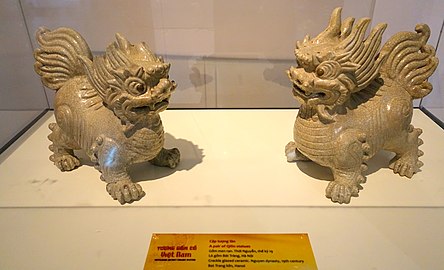Qilin
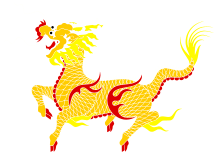 Traditional Chinese depiction of a qilin | |
| Grouping | Mythical creature |
|---|---|
| Sub grouping | Chimera |
| Similar entities | kirin, kỳ lân, gilen |
| First attested | 5th century BCE |
| Country | China |
| Qilin | |||
|---|---|---|---|
 "Qilin" in Chinese characters | |||
| Chinese | 麒麟 | ||
| |||

The qilin ([tɕʰǐ.lǐn]; Chinese: 麒麟) is a mythical hooved chimerical creature that appears in Chinese mythology, and is said to appear with the imminent arrival or passing of a sage or illustrious ruler.[1] Qilin are a specific type of the lin mythological family of one-horned beasts.
Origins[]


The earliest references to the qilin are in the 5th century BCE Zuo Zhuan.[2][3] The qilin made appearances in a variety of subsequent Chinese works of history and fiction, such as Feng Shen Bang. Emperor Wu of Han apparently captured a live qilin in 122 BC, although Sima Qian was skeptical of this.[4][better source needed]
The legendary image of the qilin became associated with the image of the giraffe in the Ming dynasty.[5][6] The identification of the qilin with giraffes began after Zheng He's 15th-century voyage to East Africa (landing, among other places, in modern-day Somalia). The Ming Dynasty bought giraffes from the Somali merchants along with zebras, incense, and various other exotic animals.[7] Zheng He's fleet brought back two giraffes to Nanjing and they were referred to as "qilins", with giraffe meaning geri in Somali.[8] The Emperor proclaimed the giraffes magical creatures, whose capture signaled the greatness of his power.
It is said that the female is called the lin (麟), the male is called the qi (麒) and "qilin" is a designation for the whole species. However, "lin" alone often carries the same generic meaning.[9]
The identification between the qilin and the giraffe is supported by some attributes of the qilin, including its herbivory and quiet nature. Its reputed ability to "walk on grass without disturbing it" may be related to the giraffe's long, thin legs. Also, the qilin is described as having antlers like a deer and scales like a dragon or fish; since the giraffe has horn-like "ossicones" on its head and a tessellated coat pattern that looks like scales, it is easy to draw an analogy between the two creatures. The identification of qilin with giraffes has had a lasting influence: even today, the same word is used for the mythical animal and the giraffe in both Korean and Japanese.[10]
Axel Schuessler reconstructs 麒麟's Old Chinese pronunciation as *gərin. Finnish linguist Juha Janhunen tentatively compares *gərin to an etymon reconstructed as *kalimV,[11] denoting "whale"; and represented in the language isolate Nivkh and four different language families Tungusic, Mongolic, Turkic and Samoyedic, wherein *kalay(ә)ng means "whale" (in Nenets) and *kalVyǝ "mammoth" (in Enets and Nganasan). As even aborigines "vaguely familiar with the underlying real animals" often confuse the whale, mammoth, and unicorn: they conceptualized the mammoth and whale as aquatic, as well as the mammoth and unicorn possessing a single horn; for inland populations, the extant whale "remains [...] an abstraction, in this respect being no different from the extinct mammoth or the truly mythical unicorn." However, Janhunen cautiously remarks that "[t]he formal and semantic similarity between *kilin < *gilin ~ *gïlin 'unicorn' and *kalimV 'whale' (but also Samoyedic *kalay- 'mammoth') is sufficient to support, though perhaps not confirm, the hypothesis of an etymological connection", and also notes a possible connection between Old Chinese and Mongolian (*)kers ~ (*)keris ~ (*)kiris "rhinoceros" (Khalkha: хирс).[12]
Description[]
Qilin generally have Chinese dragon-like features: similar heads with antlers, eyes with thick eyelashes, manes that always flow upward, and beards. The body is fully or partially scaled and often shaped like an ox, deer, or horse. They are always shown with cloven hooves. While dragons in China (and thus qilin) are also most commonly depicted as golden, qilin may be of any color or even various colors, and can be depicted as bejeweled or exhibiting a jewel-like brilliance. Common color choices for depictions are often associated with the elements, precious metals, stars, and gemstones, but can additionally include earth-tones and modest browns.
The qilin is depicted throughout a wide range of Chinese art, sometimes with parts of their bodies on fire. On occasion, they will have feathery features or decorations, fluffy curly tufts of hair, as depicted in Ming Dynasty horse art on various parts of the legs, from fetlocks to upper legs, or even with decorative fish-like fins as embellishments, or carp fish whiskers, or scales.[citation needed] It is said their auspicious voice sounds like the tinkling of bells, chimes, and the wind.[citation needed]
There are variations in the appearance of the qilin in historical China, owing to cultural differences between dynasties and regions. During the Jin dynasty, the qilin was depicted as wreathed in flame and smoke, with a dragon-like head, scales, and the body of a powerful hooved beast such as a horse. In the Ming dynasty (1368–1644), the qilin was represented as an oxen-hoofed animal with a dragon-like head surmounted by a pair of horns and flame-like head ornaments. The qilin of China's subsequent Manchu Qing dynasty (1644–1911) was a particular fanciful animal with the head of a dragon, the antlers of a deer, the skin and scales of a fish, the hooves of an ox and tail of a lion.
According to Taoist mythology, although they can look fearsome, qilin only punish the wicked; thus there exist accounts of court trials and judgments based on qilin divinely knowing whether a defendant is good or evil, guilty or innocent, in ancient lore and stories.[citation needed]
In Buddhist-influenced depictions, qilin will refuse to walk upon grass for fear of harming a single blade, and thus are often depicted walking upon the clouds or the water. As they are divine and peaceful creatures, their diets do not include flesh. They take great care when they walk to never tread on a living creature, and appear only in areas ruled by a wise and benevolent leader, which can include a household.[clarification needed] Qilin can become fierce if a pure person is threatened by a malicious one, spouting flames from their mouths and exercising other fearsome powers that vary from story to story.[citation needed]

Legends tell that qilin have appeared in the garden of the legendary Yellow Emperor and in the capital of Emperor Yao; both events bore testimony to the benevolent nature of the rulers. It has also been told that the birth of the great sage Confucius was foretold by the arrival of a qilin.[1] Qilin are also thought to be symbols of luck, good omens, protection, prosperity, success and longevity by the Chinese; they may additionally appear as symbols of fertility, often depicted as bringing a baby to a family.[citation needed]
In ritual dances[]
Some stories[which?] state that qilin are sacred pets (or familiars) of the deities.[citation needed] In the hierarchy of traditional dances performed by the Chinese (e.g., lion dance, dragon dance), they rank highly, and are third only to the dragon and phoenix.[citation needed]
In the qilin dance, movements are characterized by fast, powerful strokes of the head. The Qilin Dance is often regarded as a hard dance to perform due to the weight of the head, the stances involved, and the emphasis on sudden bursts of energy (法劲; 法勁; fǎjìn).
Qilin as unicorns[]

In modern times, the depictions of qilin have often fused with the Western concept of unicorns. Qilin (麒麟) is often translated into English as "unicorn", and can sometimes be depicted as having a single horn - although this is misleading, as qilin may also be depicted as having two horns, and a separate word, "one-horned beast" (独角兽; 獨角獸; Dújiǎoshòu) is used in modern Chinese for "unicorns". A number of different Chinese mythical creatures can be depicted with a single horn, and a qilin, even if depicted with one horn, would be called a "one-horned qilin" in Chinese, not a "unicorn".
Nevertheless, the mythical and etymological connections between the creatures have been noted by various cultural studies[10][11][12] and even the Chinese government, which has minted silver, gold, and platinum commemorative coins depicting both archetypal creatures.[13]

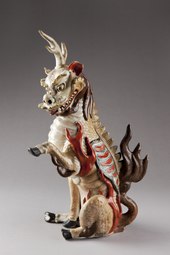
Other cultural representations[]
East Asia[]
Japan[]
Kirin is the Japanese form of "qilin", which has also come to be used in the modern Japanese word for a giraffe. Japanese art tends to depict the kirin as more deer-like than in Chinese art. Alternatively, it is depicted as a dragon shaped like a deer, but with an ox's tail[14] instead of a lion's tail. They are also often portrayed as partially unicorn-like in appearance, but with a backwards curving horn.
In the Post-Qin Chinese hierarchy of mythological animals, the qilin is ranked as the third most powerful creature (after the dragon and phoenix), but in Japan, the kirin occupies the top spot. This is following the style of the ancient Chinese, as qilin was ranked higher than the dragon or phoenix before the Qin dynasty. During the Zhou dynasty, the qilin was ranked the highest, the phoenix ranked second, and the dragon the third.[citation needed]
Korea[]
Girin, Kirin, or 기린 is the Korean form of "qilin". It is described as a maned creature with the torso of a deer, an ox tail with the hooves of a horse. The qilin in Korean art were initially depicted as more deer-like, however over time they have transformed into more horse-like.[15] They were one of the four divine creatures along with the dragon, phoenix and turtle. Qilin were extensively used in Korean royal and Buddhist arts.
In modern Korean, the term "girin" is used for "giraffe".
Southeast Asia[]
Thailand[]
In Thailand, the qilin is known as "gilen" (Thai: กิเลน), and is a member of the pantheon of Thai Himapant forest mythical animals. It is most probable that the Gilen was introduced into the pantheon under the influence of the Tai Yai who came down from Southern China to settle in Siam in ancient times, and the legend was probably incorporated into the Himapant legends of Siam in this manner. The Gilen is a mixture of various animals, which come from differing elemental environments, representing elemental magical forces present within each personified creature. Many of the Himapant animals actually represent gods and devas of the Celestial Realms, and bodhisattvas, who manifest as personifications which represent the true nature of each creature deity through the symbolism of the various body parts amalgamated into the design of the Mythical creature.[16]
In Phra Aphai Mani, the masterpiece epic poem of Sunthorn Phu, a renowned poet of the 18th century. There is a monster that is Sudsakorn's steed, one of the main characters in the epic. This creature was called "Ma Nin Mangkorn" (Thai: ม้านิลมังกร, "ceylonite dragon horse"), it is depicted as it has diamond fangs, ceylonite scales, and a birthmark on the tongue. It was a mixture of horse, dragon, deer antlers, fish scales, and Phaya Nak tail, with has black sequins all over. Its appearance resembles a qilin.[17]
Vietnam[]
In Vietnam, the qilin is referred to as kỳ lân. The origins of the kỳ lân is descended from the Chinese qilin, and shares many similar features, such as the head of a dragon or tiger, mane of a lion, the hooves of an ox or horse, the tail of a lion or ox, scales of a fish, and it can have either 1 or 2 horns or antlers.
Other representations in media[]
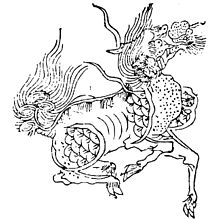
The qilin has also been frequently depicted in contemporary and modern works of literature, art and other media:
- In Jorge Luis Borges's Book of Imaginary Beings, there is a section on "The Unicorn of China".
- In Takashi Miike's The Great Yokai War, the hero is bitten during a street festival by the dancer's kirin head. According to local custom that makes him the next "kirin rider", a hero who defeats malevolent yokai; he is seen riding the kirin through the skies at the climax of the film.
- In The Twelve Kingdoms anime series, based on the fantasy novels by Fuyumi Ono, the monarch of each kingdom is chosen by a kirin, who then becomes his or her principal counselor.[18]
- In the Dungeons & Dragons universe, the Ki-rin are monsters in the Oriental Adventures setting, cited as an example of how D&D uses influences from many places.[19][20]
- The computer game NetHack, which draws heavily from Dungeons & Dragons among other sources, includes the ki-rin as an angelic being and a minion of lawful gods.
- In the video game series Final Fantasy, Kirin is one of the Espers (summoned monsters) in Final Fantasy VI and Final Fantasy Tactics Advance. Kirin also makes an appearance as the strongest of the "gods" in Final Fantasy XI, and is a mount available in Final Fantasy XIV.[21]
- In Gosei Sentai Dairanger, Kazu of the Heavenly Time Star uses his Chi to manifest the power of the kirin to become the KirinRanger (キリンレンジャー, Kirin Renjā) and pilots the Mythical Chi Beast Star-Kirin (気伝獣星麒麟, Kidenjū Sei-Kirin).[22]
- At the beginning of 47 Ronin, a Kirin is sent to kill Lord Asano in the forest of Akō, where it is then hunted by his samurai.
- In the video game series Monster Hunter, the Kirin are classified as one of the Elder Dragons. Resembling a unicorn covered in scales, they are extremely agile and can summon lightning at will.
- The Kirin Brewery Company, Limited (麒麟麦酒株式会社) is a Japanese brewery company which has a Kirin prominently featured on its logo.[23]
- In My Little Pony: Friendship Is Magic, kirin are introduced in the season eight episode "Sounds of Silence". They are here depicted as a type of pony. When angered they transform into fiery destructive creatures known as nirik (their name spelled backwards).[24]
- In the Marvel Studios film Shang-Chi and the Legend of the Ten Rings, qilin appear alongside other creatures of Chinese mythology as inhabitants of the mystical realm of Ta-Lo.
Gallery[]

A Ming-era painting of a tribute giraffe, which was thought to be a qilin by court officials, from Bengal
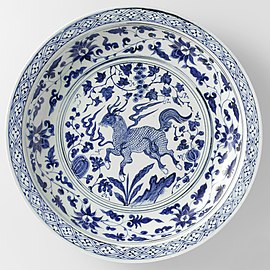
Plate with a qilin in the center, Yuan dynasty
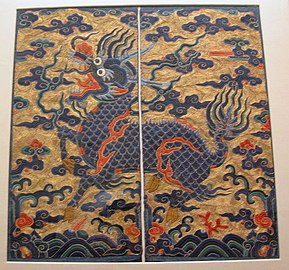
Embroidered qilin, Qing dynasty
Kỳ Lân statues, Bat Trang kiln, Hanoi, Nguyen dynasty, crackle glaze ceramics – National Museum of Vietnamese History

The logo of Kirin Beer features a depiction of the qilin (kirin)
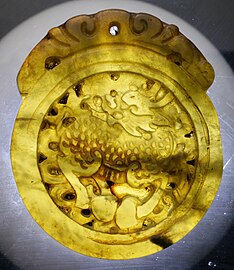
Qilin pendant
Qilin white porcelain sculpture

Qilin guard in Fuling Tomb Shenyang
Qilin incense burner, World Museum Liverpool

Vermilion Bird and Qilin
Qilin incense burner (one of a pair), World Museum Liverpool
See also[]
- Nian
- Chinthe
- Chimera
- Chinese dragon
- Four Holy Beasts
- Giraffe
- Longma
- Pixiu
- Questing Beast
- Serpopard
- Shaanxi Kylins
- Shisa
- Singha
- Sin-you
- Sudsakorn (involving a similar creature that aided the protagonist, known as Mar Nin Mang Korn)
- Unicorn
- Xiezhi
- Yali
References[]
- ^ Jump up to: a b "qilin (Chinese mythology)". Encyclopædia Britannica. Retrieved 24 July 2011.
- ^ Chinese Literature – Chunqiu-Zuozhuan 春秋左傳, Gongyangzhuan 公羊傳, Guliangzhuan 穀梁傳 (www.chinaknowledge.de)
- ^ 古建上的主要装饰纹样――麒麟 古建园林技术-作者:徐华铛 Archived 30 September 2007 at the Wayback Machine
- ^ zh:s:史記/卷028
- ^ 此“麟”非彼“麟”专家称萨摩麟并非传说中麒麟
- ^ 傳說中的聖獸—麒麟[permanent dead link]
- ^ Wilson, Samuel M. "The Emperor's Giraffe", Natural History Vol. 101, No. 12, December 1992 "Archived copy". Archived from the original on 2 December 2008. Retrieved 14 April 2012.CS1 maint: archived copy as title (link)
- ^ 傳世麒麟圖考察初稿 張之傑[permanent dead link]
- ^ ChinaKnowledge.de
- ^ Jump up to: a b Parker, J. T.:" The Mythic Chinese Unicorn"
- ^ Jump up to: a b Janhunen, J. (2011). Unicorn, Mammoth, Whale: mythological and etymological connections of zoonyms in North and East Asia. Linguistics, Archaeology and the Human Past, Occasional Paper, 12, 189–222.
- ^ Jump up to: a b Хирс in Bolor dictionary
- ^ "5 Yuan, China". en.numista.com. Numista. Retrieved 13 December 2017.
- ^ Griffis, William Elliot (October 2007). The Religions of Japan. Bibliobazaar. p. 39. ISBN 978-1-4264-9918-0.
- ^ 기린 : 네이버캐스트
- ^ "Taep Payatorn Riding Qilin Himapant Lion Hlang Yant – Nuea Pong Maha Sanaeh Luan – Ajarn Warut – Wat Pong Wonaram". Buddha Magic Multimedia & Publications. Retrieved 12 January 2016.
- ^ Pralongchoeng, Gilen (20 September 2014). "ม้ามังกร" [Dragon horse]. Thai Rath (in Thai). Retrieved 7 August 2021.
- ^ Twelve Kingdoms Kirin
- ^ Rubin, Jonathan (6 March 2008). "Farewell to the Dungeon Master: How D&D creator Gary Gygax changed geekdom forever."" Slate.com. Accessed February 2012.
- ^ AD&D Monster Manual
- ^ FFVI Espers Kirin
- ^ "Gosei Sentai Dairanger". Toei Entertainment. Retrieved 24 November 2015.
- ^ "The Kirin: a mythological beast that portends happiness". Kirin Brewing company. Archived from the original on 15 June 2012. Retrieved 28 September 2012.
- ^ Sounds of Silence, retrieved 19 November 2019
External links[]
 Media related to Qilin at Wikimedia Commons
Media related to Qilin at Wikimedia Commons
- Chinese legendary creatures
- Fictional giraffes
- Four benevolent animals
- Japanese legendary creatures
- Korean legendary creatures
- Mythological deer
- Unicorns



